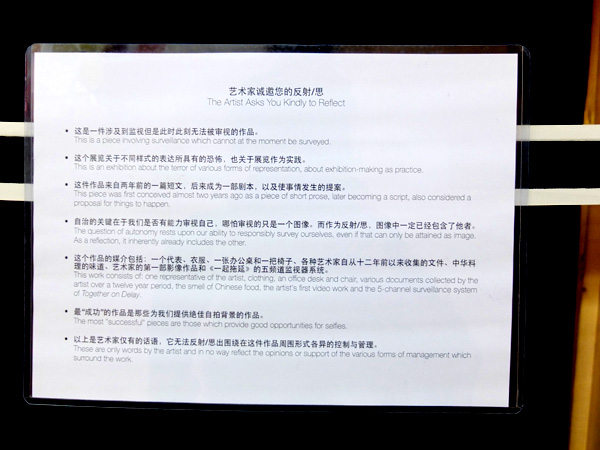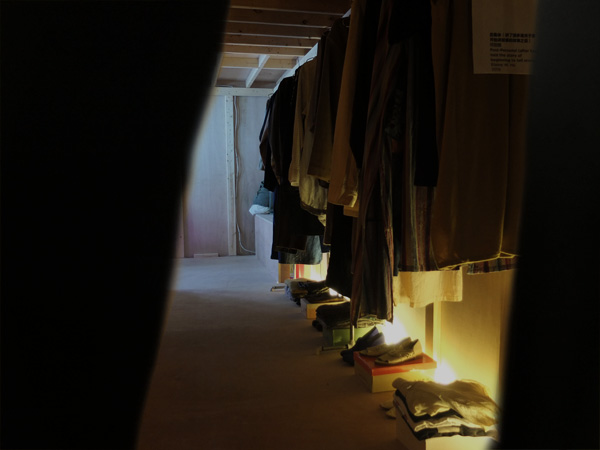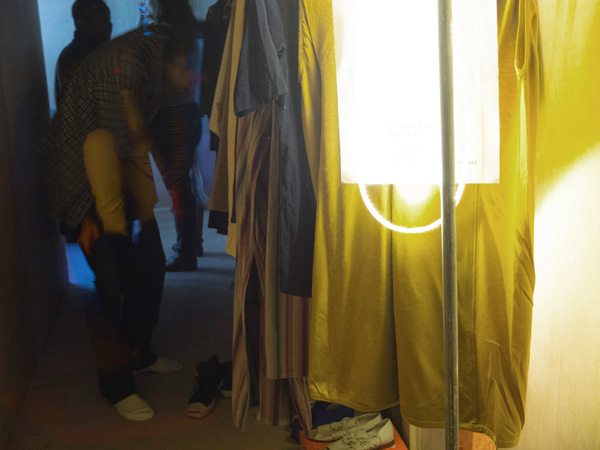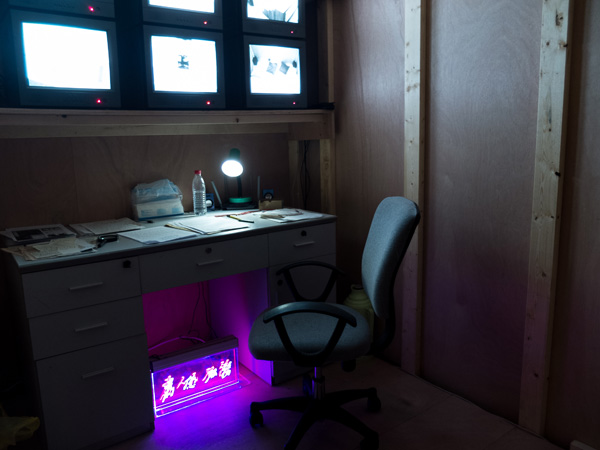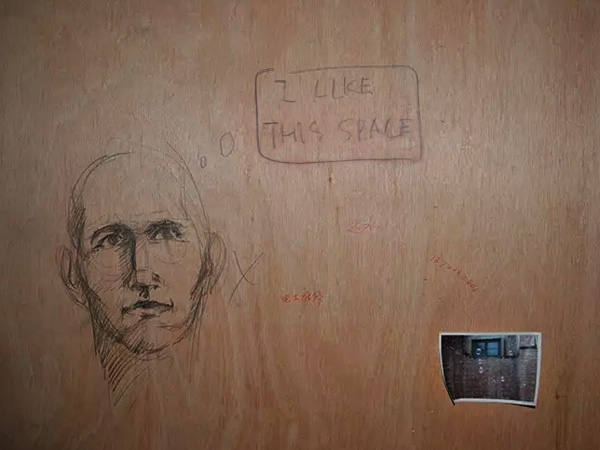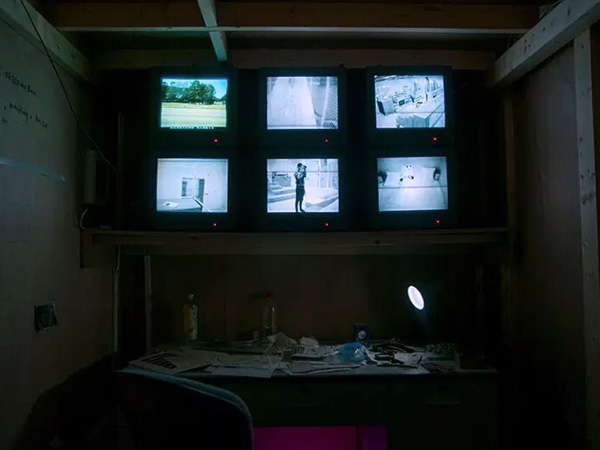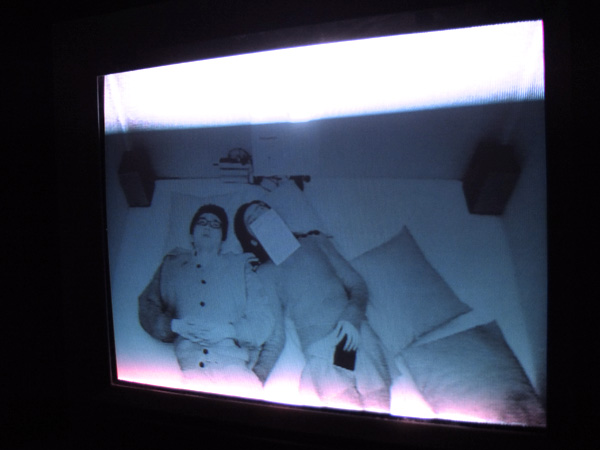The Nightmare of the Exhibition (Part II): The Bilateral Theater
installation
curated by 姚梦溪 YAO Mengxi and 张涵露 ZHANG Hanlu
上海当代艺术博物馆 Power Station of Art, Shanghai
Loose personal narratives (about) become a script (to do) for an installation (being in). A reflection reflects.
The work is housed in a dark space underneath a large plywood construction built by the curators as a discursive exhibition platform. Inside this space, a narrow corridor is lined with a clothing rack leading to a cramped, makeshift office, similar to those used by security personnel in office buildings. The 5-channel surveillance system monitors the rest of the exhibition space; it is the point when a script becomes a conversation, and together with the curators, we title it 《一起拖延 Together on Delay》. The sixth monitor plays the first video work made by the artist, For Ann, Building a House. There is a strong smell of cheap Chinese food hanging in the air.
姚梦溪,《展览的噩梦》策展人:
用何颖雅话说:"我那个空间就是有了公厕的亲密感",这是我们都没有想到的。藏在单侧楼梯下的空间,摆放有桌椅、衣物、日常用品,桌上的文件随意自在。面对这个环境观众是习惯且适应的,能与日常生活中,对某些空间(小区门卫室、大厦监控房)的记忆连接。而监控室主角的缺席,赋予每一位进入者主人身份,观众在墙上涂画、桌上留言,抽屉代表树洞接收一切秘密,充满私密性和暧昧。试图去了解这一情境时,就已经进入还湿了身,成为这出隐藏戏剧的主角。
由何颍雅记忆碎片拼凑的空间,并不停留在回忆里。剧本早就写好,主角暂时缺席,任何人进入都接替作者将故事续写,不断地再生产。为了放弃主观身份,艺术家曲一箴被邀请来代替何颍雅,在展厅里工作两个月,这是整场戏剧非常重要的部分,艺术家留给我们一个问题:"抛掉作者的主观后是不是客观的?
何颍雅在作品里不断提示空间的客观存在,而我们永远身在其中,不论社会空间还是在美术馆,我们离不开环境。隐藏空间被装扮成"监控室",使观者躲在屏幕后面,用更习惯的方式看展览。五台监控塑造了一系列重点视角,不可移动的机位给出了主观的展厅图像,同时这也透露出媒体化的选择特点,具有消费性和压迫性。所以观众再一次被限定在现有系统里。
The work is housed in a dark space underneath a large plywood construction built by the curators as a discursive exhibition platform. Inside this space, a narrow corridor is lined with a clothing rack leading to a cramped, makeshift office, similar to those used by security personnel in office buildings. The 5-channel surveillance system monitors the rest of the exhibition space; it is the point when a script becomes a conversation, and together with the curators, we title it 《一起拖延 Together on Delay》. The sixth monitor plays the first video work made by the artist, For Ann, Building a House. There is a strong smell of cheap Chinese food hanging in the air.
姚梦溪,《展览的噩梦》策展人:
用何颖雅话说:"我那个空间就是有了公厕的亲密感",这是我们都没有想到的。藏在单侧楼梯下的空间,摆放有桌椅、衣物、日常用品,桌上的文件随意自在。面对这个环境观众是习惯且适应的,能与日常生活中,对某些空间(小区门卫室、大厦监控房)的记忆连接。而监控室主角的缺席,赋予每一位进入者主人身份,观众在墙上涂画、桌上留言,抽屉代表树洞接收一切秘密,充满私密性和暧昧。试图去了解这一情境时,就已经进入还湿了身,成为这出隐藏戏剧的主角。
由何颍雅记忆碎片拼凑的空间,并不停留在回忆里。剧本早就写好,主角暂时缺席,任何人进入都接替作者将故事续写,不断地再生产。为了放弃主观身份,艺术家曲一箴被邀请来代替何颍雅,在展厅里工作两个月,这是整场戏剧非常重要的部分,艺术家留给我们一个问题:"抛掉作者的主观后是不是客观的?
何颍雅在作品里不断提示空间的客观存在,而我们永远身在其中,不论社会空间还是在美术馆,我们离不开环境。隐藏空间被装扮成"监控室",使观者躲在屏幕后面,用更习惯的方式看展览。五台监控塑造了一系列重点视角,不可移动的机位给出了主观的展厅图像,同时这也透露出媒体化的选择特点,具有消费性和压迫性。所以观众再一次被限定在现有系统里。

